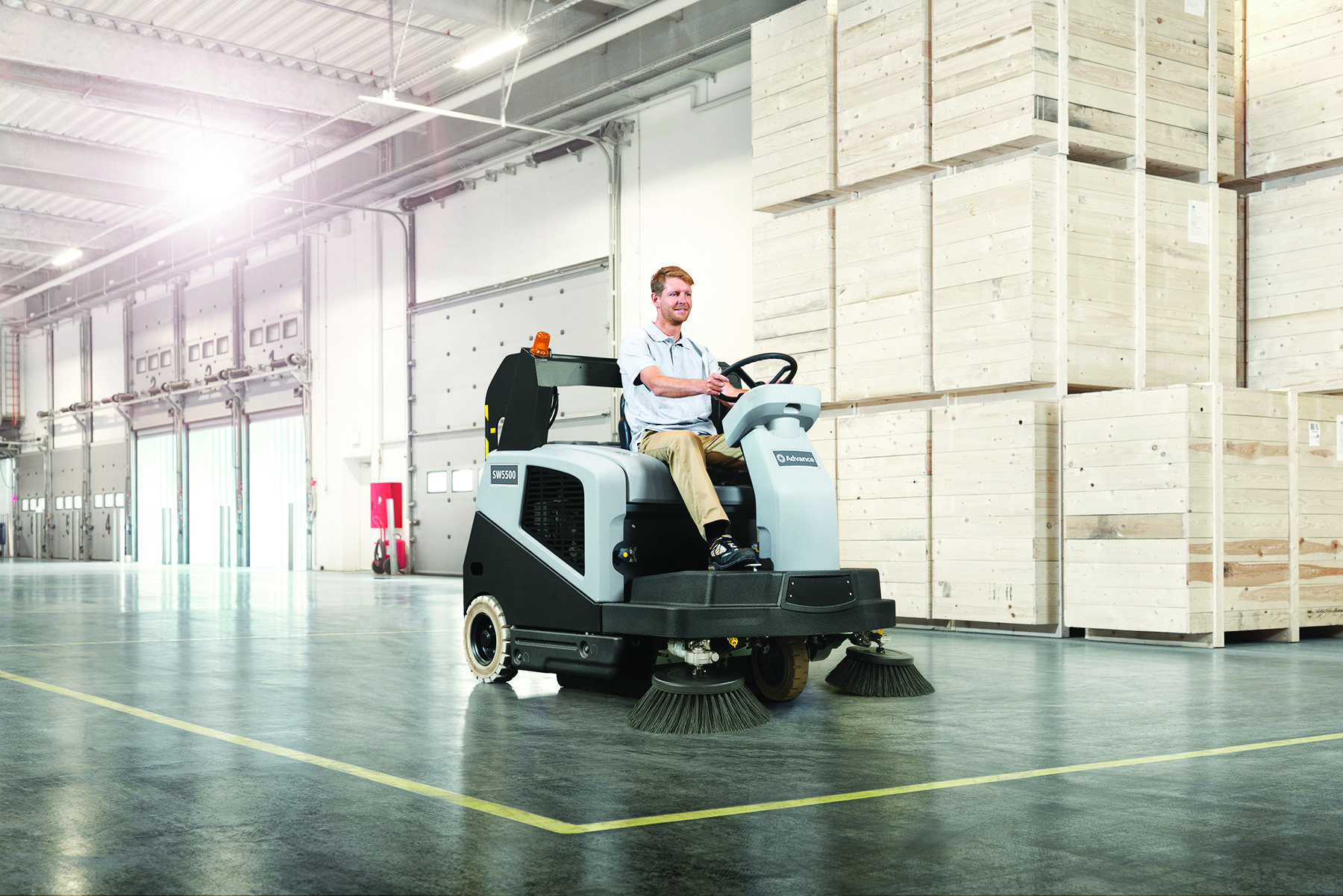In the evolving landscape of facility maintenance, transitioning from traditional sweeping to the advanced technology of industrial floor sweepers represents a huge leap in cleaning effectiveness.
These state-of-the-art sweepers excel in tasks that pose distinct challenges to traditional sweepers. From industrial facilities grappling with large debris to commercial spaces combating fine dust, these machines offer a comprehensive cleaning solution.
Whether you’re looking to maintain the concrete surface of a warehouse, the tiled floors of a food service establishment, or the carpeted interior of an office building, an industrial floor sweeper can effortlessly navigate obstacles and narrow passages. Their effectiveness goes beyond the surface-level removal of dirt, reaching down into the depths of embedded grime for a degree of cleanliness that traditional sweepers struggle to achieve.
If you haven’t already, this is the year to add an industrial floor sweeper to your facility’s cleaning and maintenance program. If you already have one but want to increase worker productivity, improve cleaning results, and extend the life of your hard floors and carpeted surfaces, now is the time to consider an upgrade.
So, how do you know which industrial floor sweeper to choose?
We’ve made the decision easier for you by putting together this guide. There are a handful of important features to consider, which we’ll break down and use for a side-by-side comparison of the best industrial floor sweepers of 2025.
Industrial Floor Sweeper Features to Consider Before Purchasing
9 key features greatly affect the capabilities and efficiencies of an industrial floor sweeper:
- Power Source
- Weight
- Cleaning Path
- Sound Level
- Debris Hopper Capacity
- Filter Accessibility
- Filter Shaker
- Filter Size
- Adjustable Handle
Let’s break down each of these features and how they can affect the industrial floor sweeper.
1. Power Source
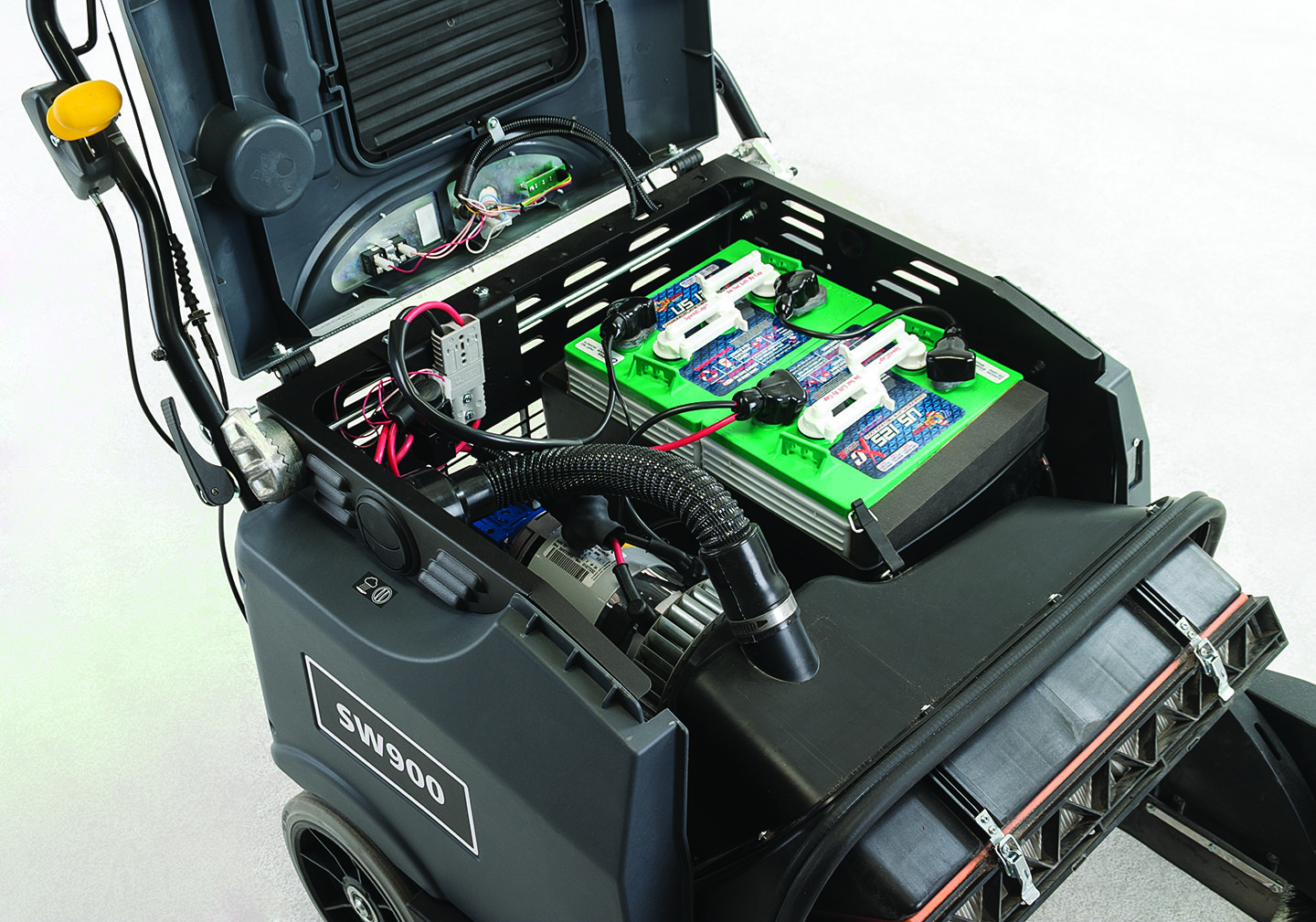
The industrial floor sweepers we’ll review in this article are all battery-operated.
Battery-operated sweepers are limited by their run time. Run time refers to the duration an industrial floor sweeper can operate on a single charge. This is a critical factor affecting performance and productivity.
Industrial floor sweepers with longer run times can operate continuously for extended periods before stopping to refuel or recharge, contributing to less downtime.
2. Weight
Weight is important to consider because it plays a big role in maneuverability, portability, and cleaning capability.
Light-duty floor sweepers weigh under 200 lbs and are generally more maneuverable than heavy-duty and industrial-grade models. As a result, they’re better equipped for navigating around obstacles and in tight spaces.
Heavy-duty and industrial floor sweepers generally weigh over 200 lbs and, while heavier and less maneuverable, offer more room for bigger hoppers and batteries. As a result, they’re better equipped for cleaning large spaces.
Also, consider that light-duty sweepers are designed for light cleaning tasks, like sweeping dust from the floor, while heavy-duty and industrial floor sweepers are designed for more intensive cleaning tasks, like sweeping dirt and debris from a parking lot.
3. Cleaning Path
Cleaning path affects an industrial floor sweeper’s efficiency and productivity.
A wide cleaning path means a sweeper can cover more ground in a single pass. This translates to faster cleaning, particularly for facilities with large, open areas, like warehouses and parking lots. An example of a wide cleaning path is 33 in.
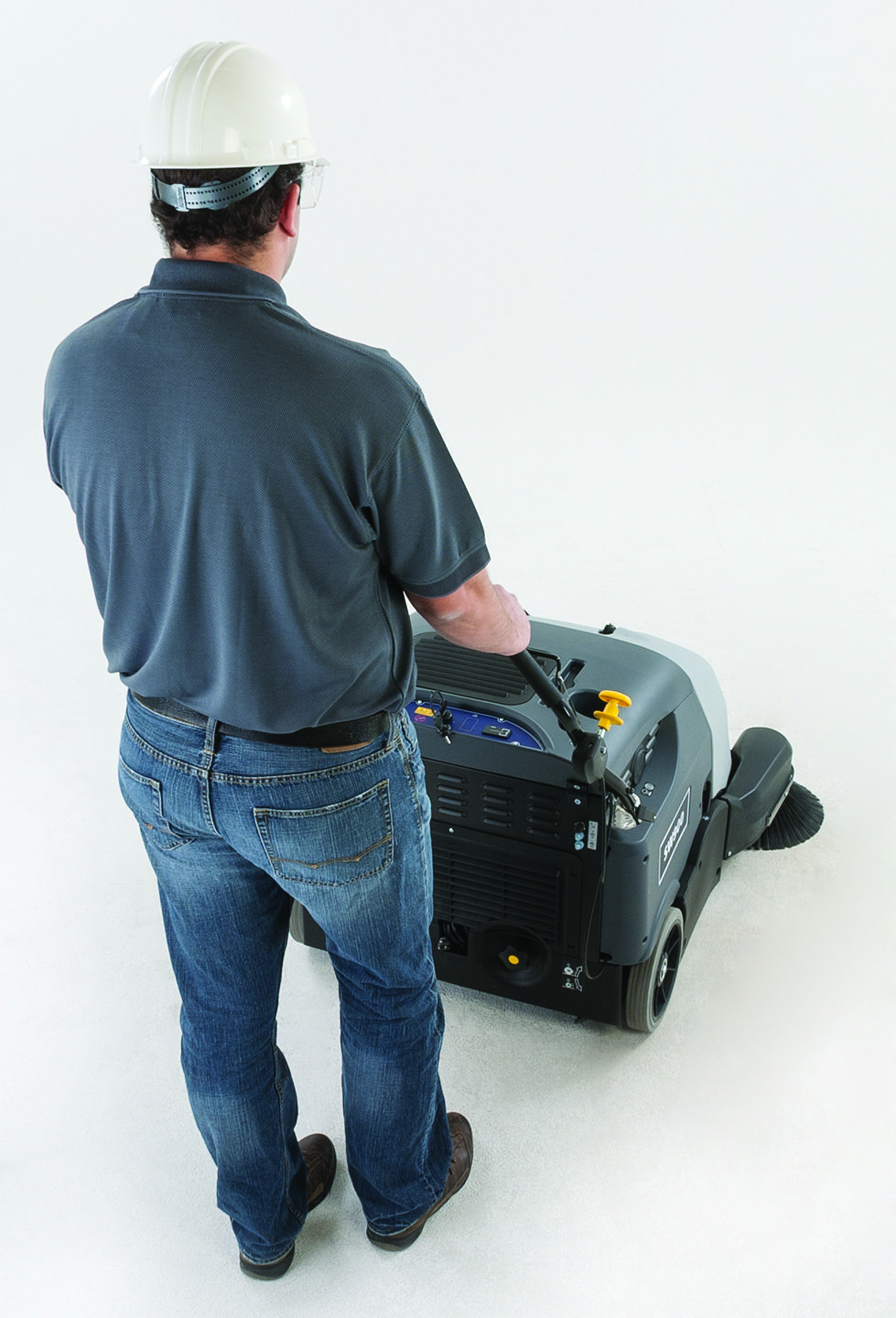
A narrow cleaning path means that a sweeper has better maneuverability. This makes a floor sweeper better suited for facilities with tight, congested areas, like office spaces and foodservice establishments. An example of a narrow cleaning path is 28 in.
4. Sound Level
Sound levels can impact both the machine operator and the surrounding environment.
The noise profile of an industrial floor sweeper ranges from 50 dBA to 70 dBA.
Lower sound emissions help foster a more comfortable working environment, allowing the operator to better focus on the task at hand. This is also true for surrounding employees and guests, who might find a louder piece of equipment distracting and disruptive.
5. Debris Hopper Capacity
Hopper capacity refers to the size of the industrial floor sweeper’s debris collection container. It directly impacts both the efficiency of the cleaning process and the machine’s suitability for specific cleaning tasks.
There are plenty of productivity-boosting benefits to a larger hopper, like more capacity for dirt and debris, longer run time before it needs to be emptied, less time spent emptying the hopper, and better efficiency in covering large areas. A larger hopper also means a machine can capture and collect bulky debris too big for a smaller hopper.
However, more capacity and larger debris also means a heavier hopper. Increased weight can negatively affect operator performance and cleaning productivity. Additionally, manually handling and emptying can be more of a hassle.
6. Filter Accessibility
Accessibility is important because it impacts the filter’s ease of maintenance, efficiency, and longevity.
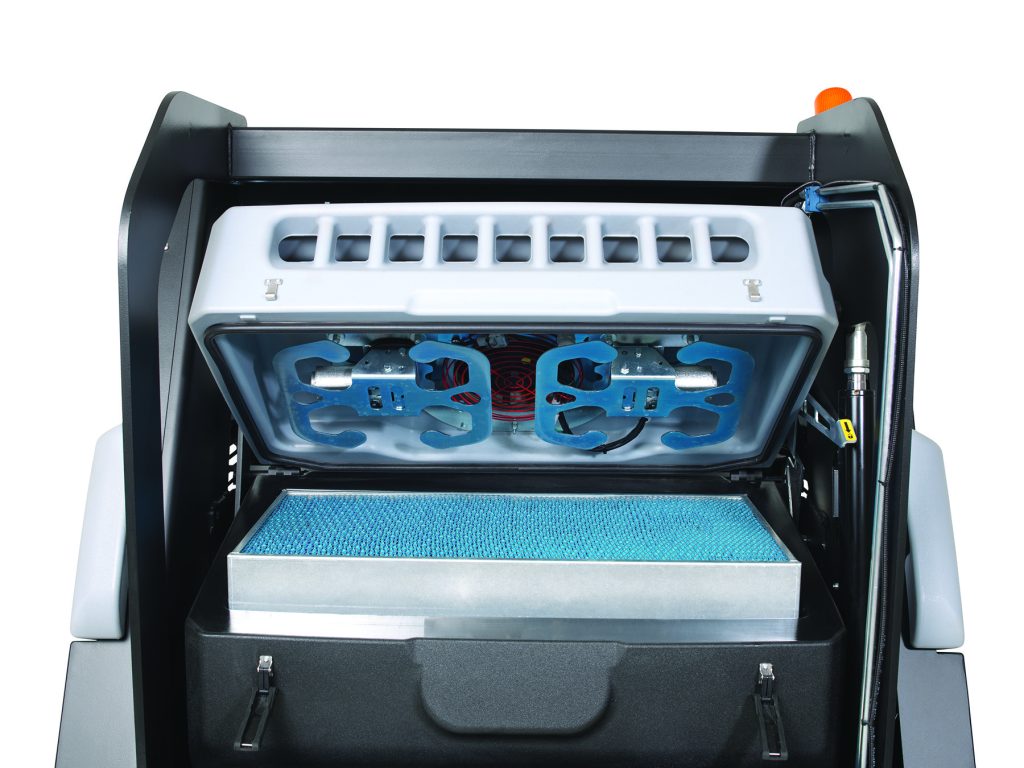
Anything that hinders accessibility to the filter, like requiring tools, is a negative quality. These obstacles decrease productivity, as employees have to spend more time accessing the filter than they would on machines with better filter access.
What tends to happen if the filter is inaccessible is that filter cleaning and maintenance are performed infrequently. An accessible filter, on the other hand, promotes regular filter cleaning and maintenance. The filter lasts longer, and the floor sweeper will maintain optimal cleaning performance.
Did You Know?: That HEPA filters have long been considered the gold standard for air purification?
7. Filter Shaker
Industrial floor sweepers come with a feature called the filter shaker. The filter shaker is responsible for keeping the filter clean, which helps maintain dust control efficacy while promoting a longer filter life.
Filter shakers are either manual or electric. Manual filter shakers must be used by hand, which can be dirty and time-consuming. As a result, using a manual filter shaker is often neglected or performed infrequently. Electric filter shakers are great because they perform this task automatically and consistently.
8. Filter Size
Filter size has a direct impact on cleaning efficiency.
Large filters can handle a greater volume of dust before they need to be cleaned. This prevents premature clogging and allows the industrial floor sweeper to maintain efficient and consistent suction power for a longer period.
Small filters may be easy to remove and clean but are prone to more frequent clogs and cleanings than large filters.
9. Adjustable Handle
An adjustable handle can be customized to meet the comfort needs of a wide range of operators. This helps combat operator fatigue. While not a deal breaker, having an industrial floor sweeper with an adjustable handle is beneficial for operator comfort.
3 Best Industrial Floor Sweepers of 2025
In no particular order, here are our picks for the best industrial floor sweepers of 2025:
- Advance SW900™
- Clarke® BSW 28
- Tennant® S7
Let’s take a closer look at what puts these industrial floor sweepers in a league of their own.
1. Advance SW900™
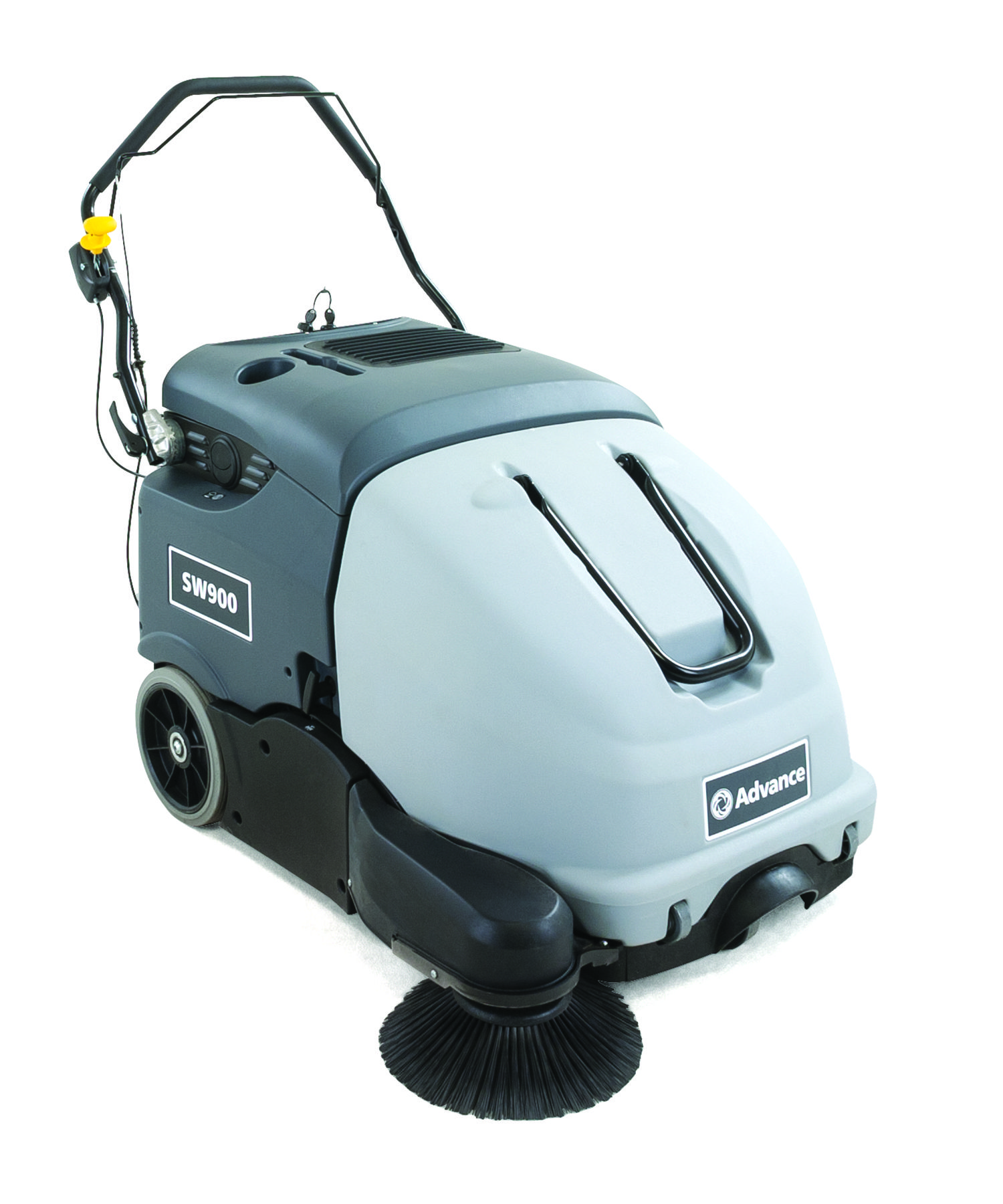
Manufactured by Nilfisk, this industrial-grade walk-behind floor sweeper redefines cleaning versatility.
Designed to maximize cleaning productivity and effectiveness, the SW900™ is just as effective indoors as it is outdoors. Not only that, but it also excels at sweeping in large commercial settings, like warehouses, hospitality facilities, and universities.
Don’t let its large size fool you, the SW900™ is built with ease-of-use and user comfort in mind. This machine features an ergonomic handlebar, intuitive control panel, and single-hand propulsion control bar for comfortable and effortless operation.
The SW900™ is the most expensive industrial floor sweeper on our list.
Power Source
This industrial floor sweeper is battery-operated.
You can expect up to 3 hours of run time on a full charge. The SW900™ does feature onboard charging, which is particularly convenient for working in areas where an electric outlet may not be readily accessible.
Weight
Weighing in at 390 lbs, this sweeper is the biggest and heaviest on our list.
Its size enables the SW900™ to have a large hopper capacity and cleaning path. This machine is better equipped to handle bigger and bulkier debris than the other sweepers we’ll review. Its size also means that operator fatigue is likely to set in sooner than it would operate a light-duty floor sweeper and that the SW900™ is far less equipped to go up inclined surfaces.
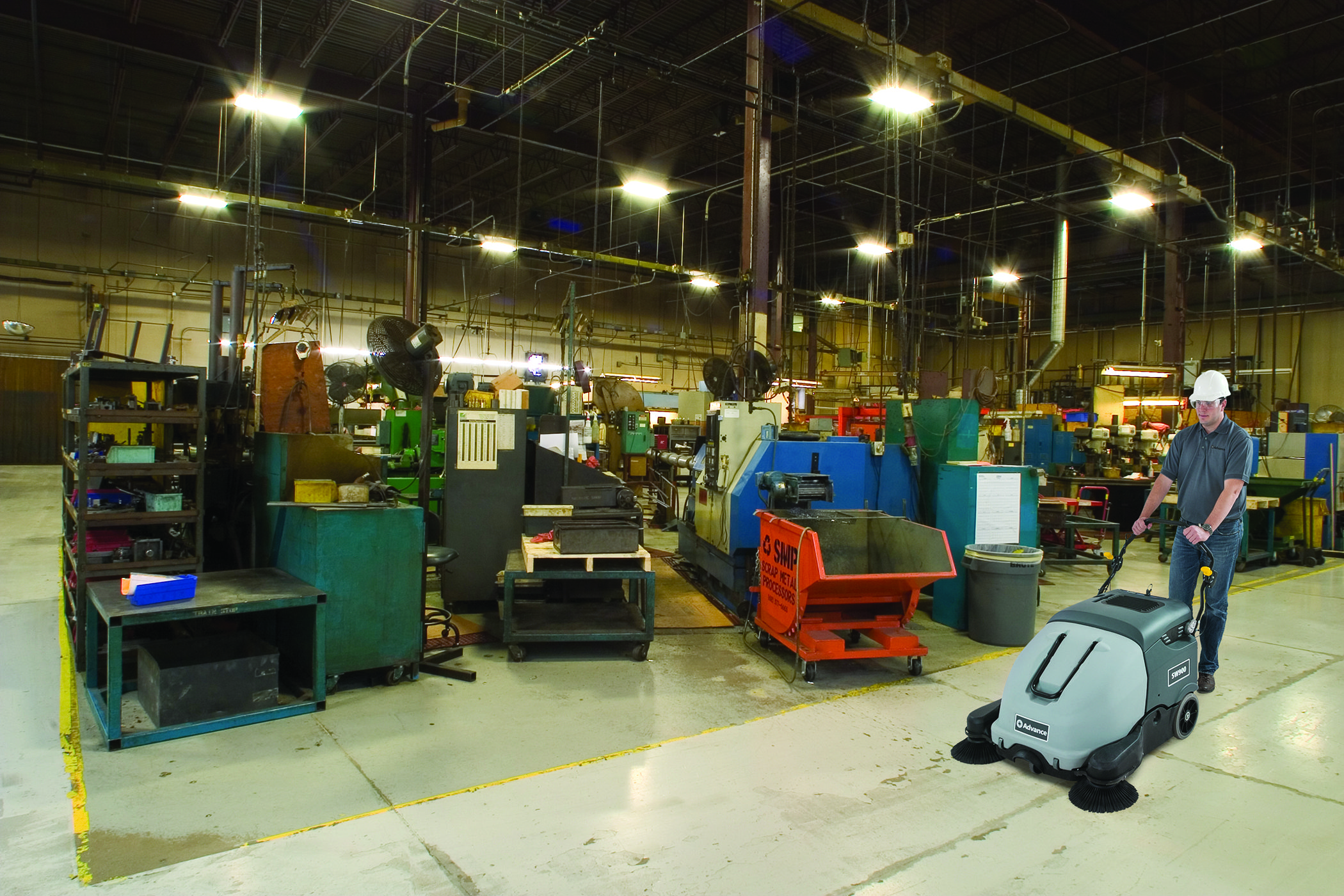
Cleaning Path
The main brush and side brush come together to give this industrial floor sweeper an impressive 33 inch cleaning path, the widest on this list.
Its wide cleaning path makes the SW900™ ideal for quickly and efficiently sweeping open areas, capturing large debris, and picking up dust.
Sound Level
The SW900™ operates at about 70 dBA, which is average for an industrial floor sweeper. For reference, 70 dBA is about the same noise level as a washing machine.
Debris Hopper Capacity
At 60 L, the SW900™ is tied with the BSW 28 for the largest hopper capacity on this list.
Its large hopper, combined with the wide cleaning path, enables this machine to pick up and container big or bulky debris. The hopper capacity also means the SW900™ can operate for longer before it needs to be emptied.
Filter Accessibility
Of all the industrial floor sweepers on this list, the SW900™ by far has the most accessible filter.
It sits behind the hopper. Some hoppers can be a hassle or require a removal process. All you have to do for this one is lift it up, using the handle on top of the hopper, and place it to the side. With that out of the way, you can easily access the hopper with no tools required.
Filter Shaker
The filter shaker on this machine is manual.
Having a manual filter shaker is generally a downside because operators neglect to use it as often as they should. However, the filter on this machine is particularly accessible, which should help motivate operators to use it more frequently.
Filter Size
Compared to the filter sizes in this guide, the SW900™ sits right in the middle. As a result, this machine may experience clogs less often than the S7 but more frequently than the BSW 28.
Adjustable Handle
The SW900™ does come equipped with an adjustable handle. It can also fold all the way down for easy transportation and convenient storage.
2. Clarke® BSW 28
Manufactured by Nilfisk, this light duty industrial floor sweeper is all about unleashing power and efficiency.
Power traction, large rear wheels, and an ergonomically designed handle come together to make the BSW 28 a powerhouse for cleaning entrances and hallways.
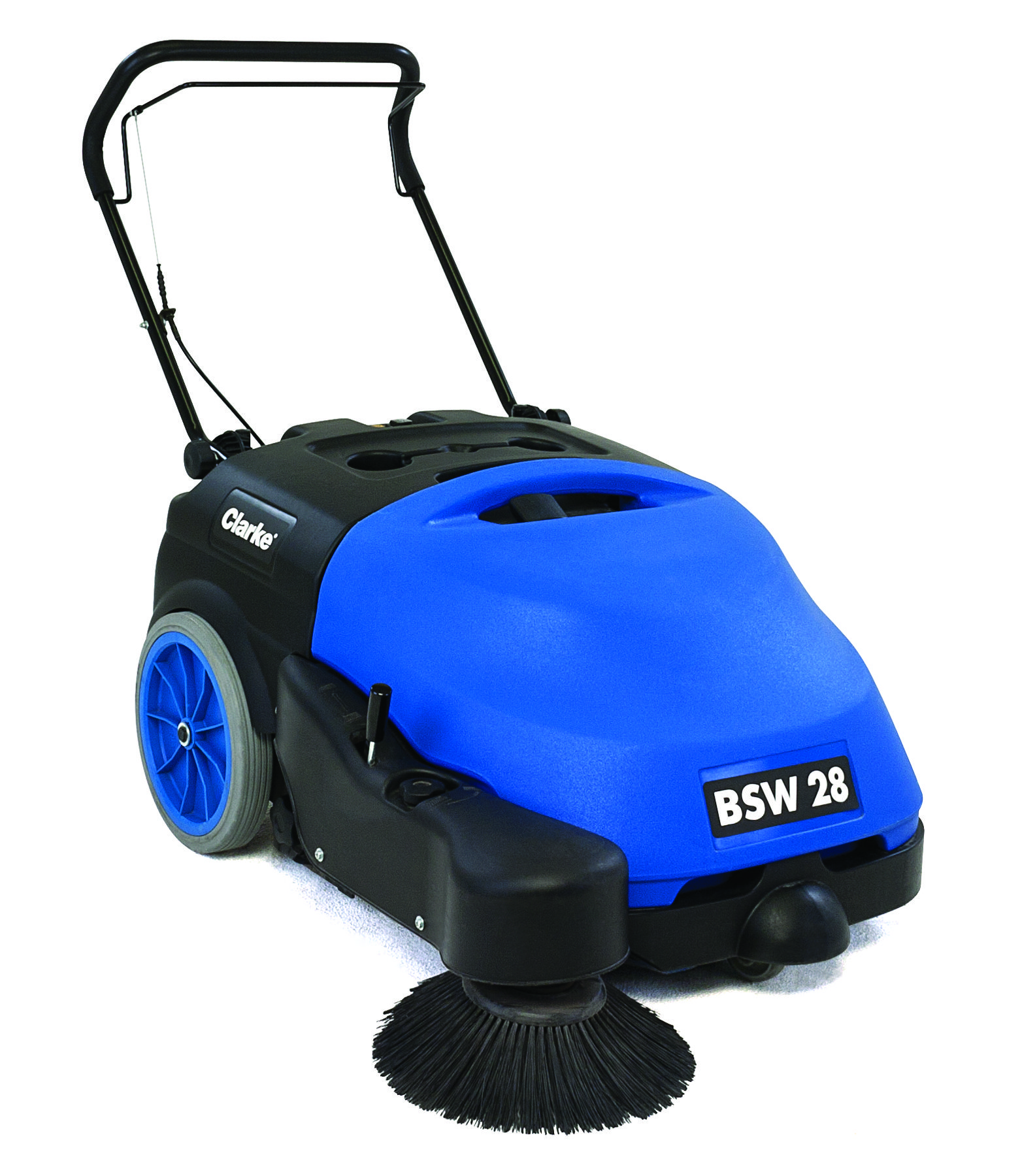
Whether you’re sweeping hard floors or carpeted surfaces, this sweeper is designed for high performance. Its generous cleaning path effectively reaches corners and crevices, while its compact and lightweight design helps prevent operator fatigue.
The BSW 28 is the least expensive industrial floor sweeper on this list, beating out the S7 by a small margin.
Power Source
This is a battery-operated industrial floor sweeper.
You can expect between 2.5 and 3 hours of run time on a full charge. This estimate puts the BSW 28 at the bottom of the pack.
Weight
Coming in at 171 lbs, the BSW 28 is the lightest sweeper on this list.
Operator fatigue is a much smaller factor with this sweeper than the others. As a result, productivity is increased. The BSW 28 is also easy to transport due to its small frame and lightweight, making this a great option for on-the-go cleaning tasks.
Cleaning Path
The BSW 28 has a total cleaning path of 28 inches, tied with the S7.
While it’s not the widest cleaning path we’ve seen, 28 in is a solid cleaning path that makes this machine more effective at tackling congested areas than wide, open spaces.

Sound Level
This floor sweeper operates at 59 dBA, making it the quietest model we’ll review.
A low noise profile fits the BSW 25’s compact, lightweight design. This machine is ideal for use in occupied commercial spaces, like offices, where disruptions should be minimal.
Debris Hopper Capacity
For a light duty floor sweeper, the BSW 28 has an impressive 60 L hopper capacity.
That’s the same hopper capacity as the SW900™ at less than half the weight. The BSW 28 can handle big debris or a large amount of debris without sacrificing portability, which makes this sweeper highly efficient.
Filter Accessibility
Filter accessibility is great on this machine.
No tools are needed to access the filter. Simply lift the hopper up by its handle, place it to the side, and unscrew the two knobs on either side of the filter and you have access to it. This process isn’t quite as effortless as it is with the SW900™, but it’s certainly a couple steps above the S7.
Filter Shaker
The filter shaker on this industrial floor sweeper is manual. Easy filter access should make using the filter shaker more approachable, but it’ll never be as approachable as an electric filter shaker.
Filter Size
Compared to the other filters on this list, the filter on the BSW 28 is the smallest. You can expect it to clog frequently and require cleanings regularly.
Adjustable Handle
The BSW 28 features an adjustable handle. The handle can be folded all the way up for easy transportation and storage, similar to the SW900™.
3. Tennant® S7
Manufactured by Tennant, this heavy duty floor sweeper is built to be a rugged and durable solution to your sweeping needs.
A steel frame and durable components are the backbone of this industrial floor sweeper, contributing to its large size. The S7 provides operators with an easy-to-use control console with battery status and discharge indicators, ensuring optimal operational performance. The side brush is adjustable so no corner gets left behind, and the main brush is designed for enhanced debris pick-up efficiency. Combine all of these features with an extremely effective dust control system, and you’ve got a great floor sweeper for food service and healthcare facilities.

This industrial floor sweeper is a little pricier than the BSW 28, making it the second most expensive model featured on this list.
Power Source
This is a battery-operated floor sweeper, just like the other two we’ve covered.
It also gets up to 3 hours on a full charge, offering ample time to complete cleaning tasks. Keep in mind that run time differs depending on a number of factors, such as surface type.
Weight
Weighing in at 267 lb, the S7 sits in the middle of the pack compared to the other industrial floor sweepers.
It’s still on the heavy side, so expect it to share some of the disadvantages of the SW900™ rather than the advantages of the BSW 28, particularly regarding operator fatigue.
Cleaning Path
Just like the BSW 28, this sweeper features a 28 in cleaning path. 28 in is on the low end of our list, but it’s still an effective width.

Sound Level
Clocking in at 70 dBA, the S7 is tied with the SW900™ for the loudest sweeper. Remember that 70 dBA isn’t too loud, but when models like the BSW 28 prioritize quiet operation, it’s something you have to consider.
Debris Hopper Capacity
The S7 has a hopper capacity of just 45 L, making it the smallest hopper on this list.
The 45 L hopper capacity is an unexpected limitation for such a heavy machine. Typically, a small hopper means a lower overall weight, but not in this case. While Tenant advertises a “flap trap” design for large debris pick up, limited capacity means that the operator must stop and empty the hopper frequently, particularly with large debris.
Filter Accessibility
Out of all the industrial floor sweepers in this guide, this one has, by far, the least accessible filter.
The other sweepers didn’t require tools to access the filter; this one does. On the other sweepers, the filter is immediately accessible after removing the hopper; this one has a foam filter cover in the way.
All in all, the process of removing the filter for cleaning and maintenance is much less user friendly than it is with the other industrial floor sweepers and does not promote frequent maintenance.
Filter Shaker
The T7 is the only industrial floor sweeper we’ve reviewed to feature an electric filter shaker.
You’ll notice that the filter requires far less maintenance and maintains efficacy for much longer when the floor sweeper has an electric filter shaker. This is because they’re so easy to use, especially compared to the hassle of using a manual filter shaker.
Filter Size
Compared to the SW900™ and BSW 28, the S7 has the largest filter. A big filter impacts cleaning efficiency, as it doesn’t need to be cleaned as often, making this a huge benefit for the S7.
Adjustable Handle
Unlike the other two industrial floor sweepers we’ve covered, the S7 does not feature an adjustable handle.
Final Thoughts
If you’re still unsure which one is best for your facility, let’s quickly recap the best industrial floor sweepers of 2025.
For facilities where productivity is key, you can’t go wrong with the Advance SW900™. Its large hopper capacity and wide cleaning path make it your best bet for a quick and effective cleaning operation. This sweeper can seamlessly transition from hard to soft floors and offers unparalleled ease of maintenance. The SW900™ may be the most expensive industrial floor sweeper in this guide, but it’s also the most efficient.
If you want to sweep busy or congested commercial spaces, look no further than the Clarke® BSW 28. Its compact, lightweight design is just as suited for sweeping narrow passageways as for maneuvering around obstacles in open areas. A low noise profile means it’ll get cleaning tasks done without causing any distractions. It’s hard to pass up on the BSW 28 at such an affordable price.
If you want a piece of equipment that’s beginner-friendly and built to last, consider the Tennant® S7. Built up from a steel frame, you’ll be hard-pressed to find a more durable, heavy-duty floor sweeper. While it’s great for use in environments where big and bulky debris is guaranteed, the S7 also features an impressive dust control system. Its easy-to-use control system and an array of status indicators ensure that any operator, no matter the experience, can utilize the power and efficiency of the S7. While it’s not as affordable as the BSW 28, this floor sweeper is far from overpriced, given its cleaning capabilities.
If you’re interested in seeing any of these industrial floor sweepers, reach out to an Imperial Dade facility near you for a free equipment demo. One of our janitorial equipment experts is available to live demo the equipment at your facility.
If you have questions about any of the equipment in this guide, you can submit them to our help center. Otherwise, reach out to an Imperial Dade facility near you to speak directly with a member of our janitorial equipment staff.
We hope this guide has been helpful! If you’re looking for the latest and greatest recommendations regarding other janitorial equipment, consider checking out one of our other Best Equipment guides, linked below.
